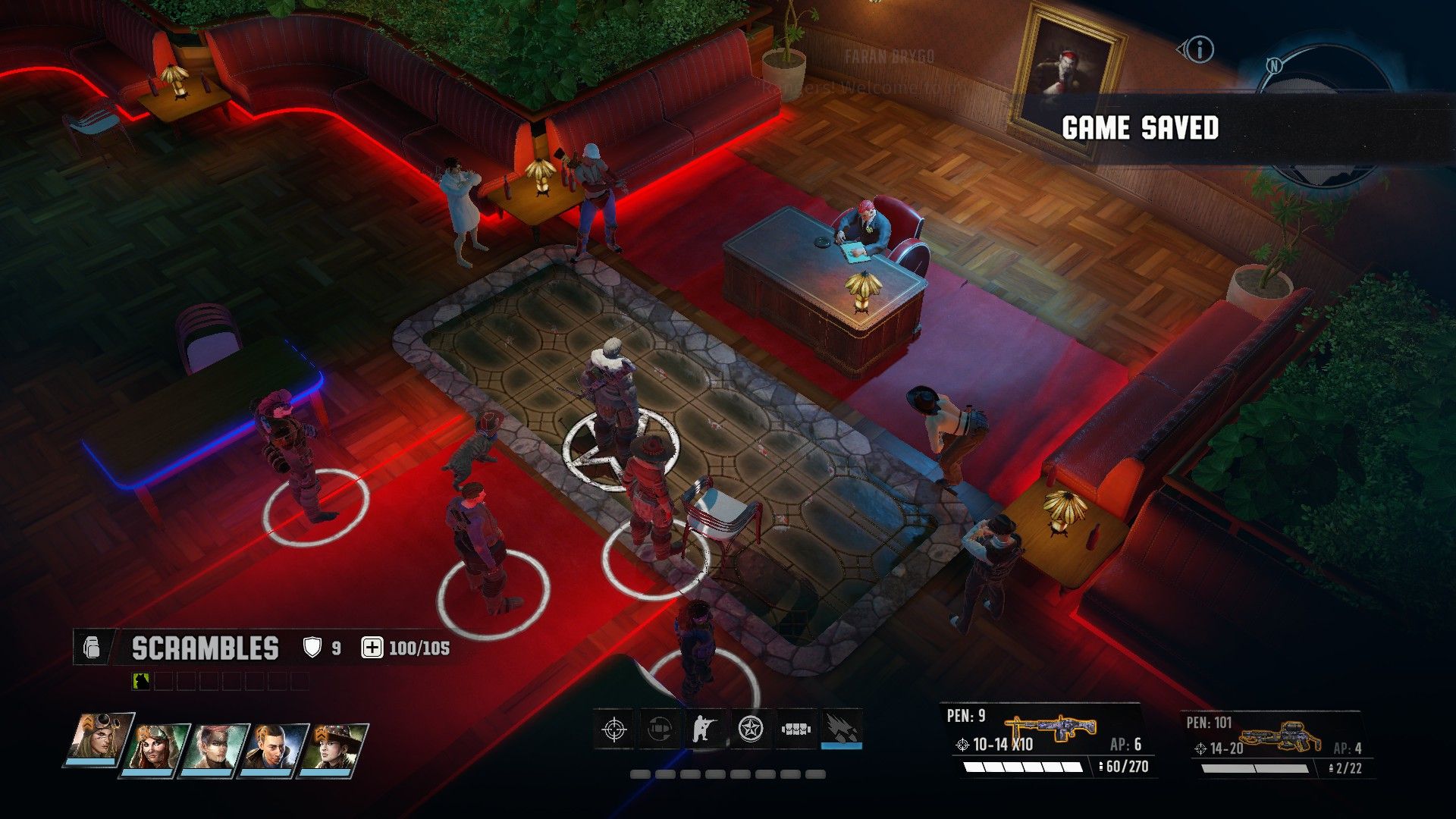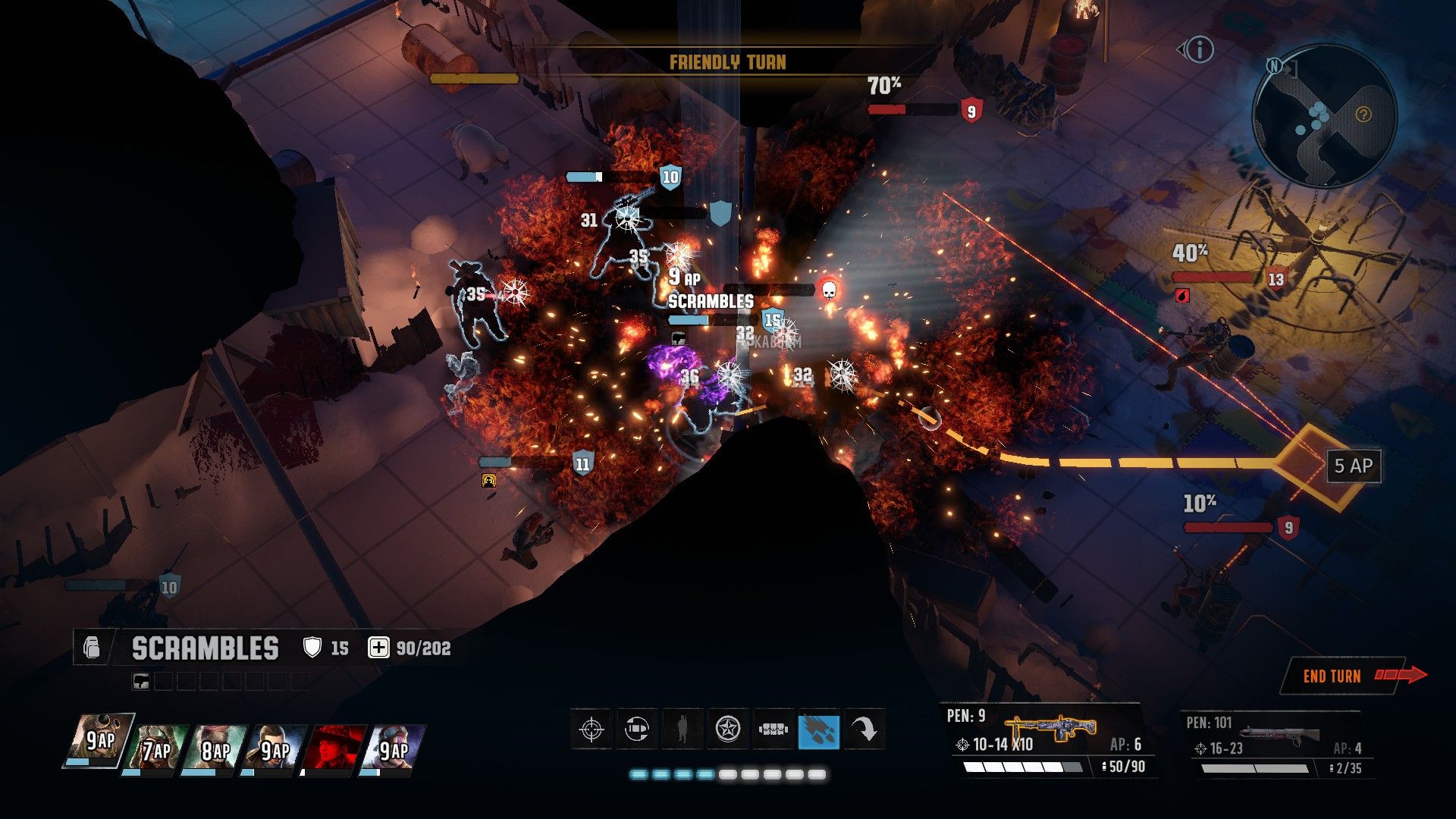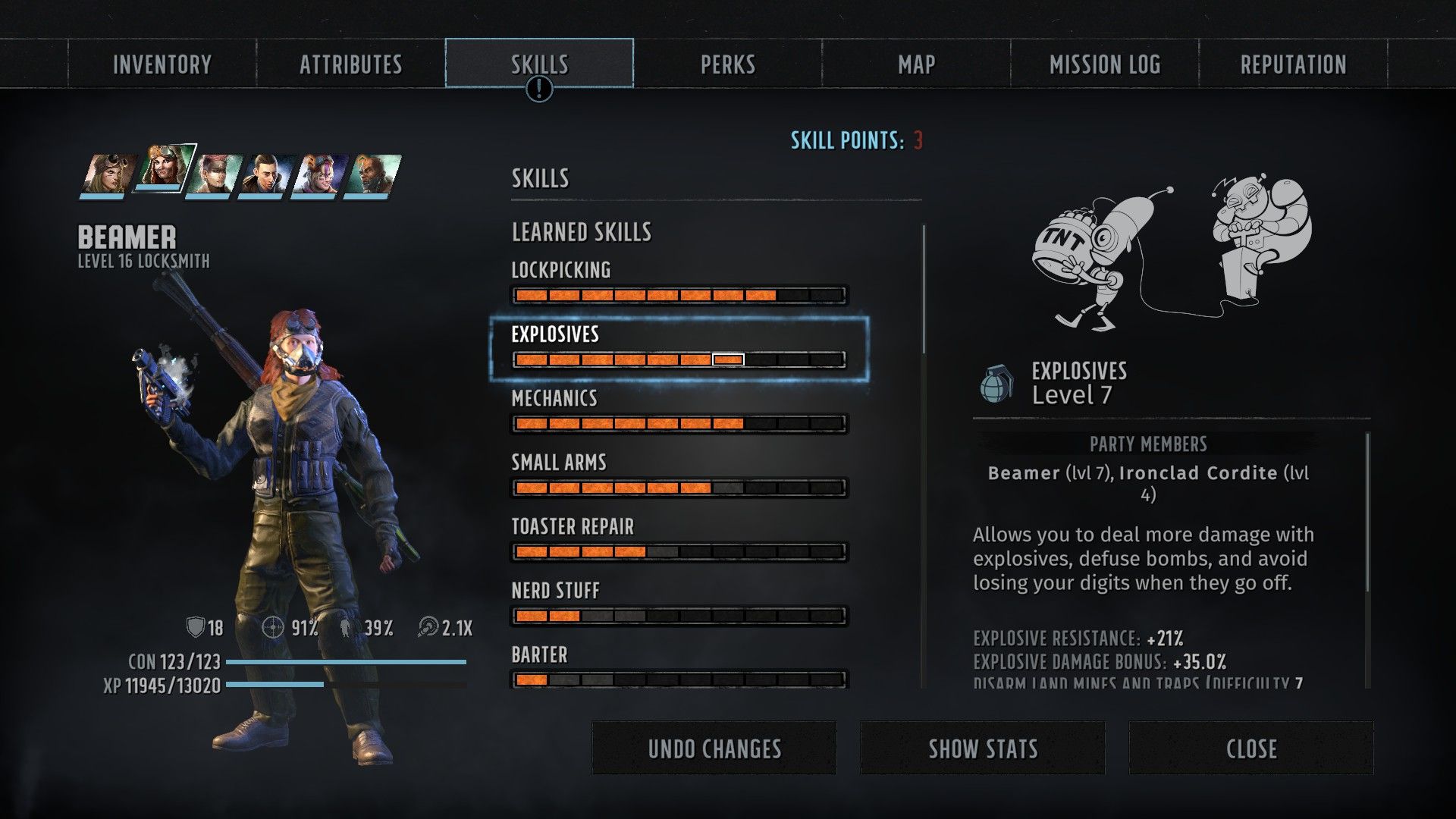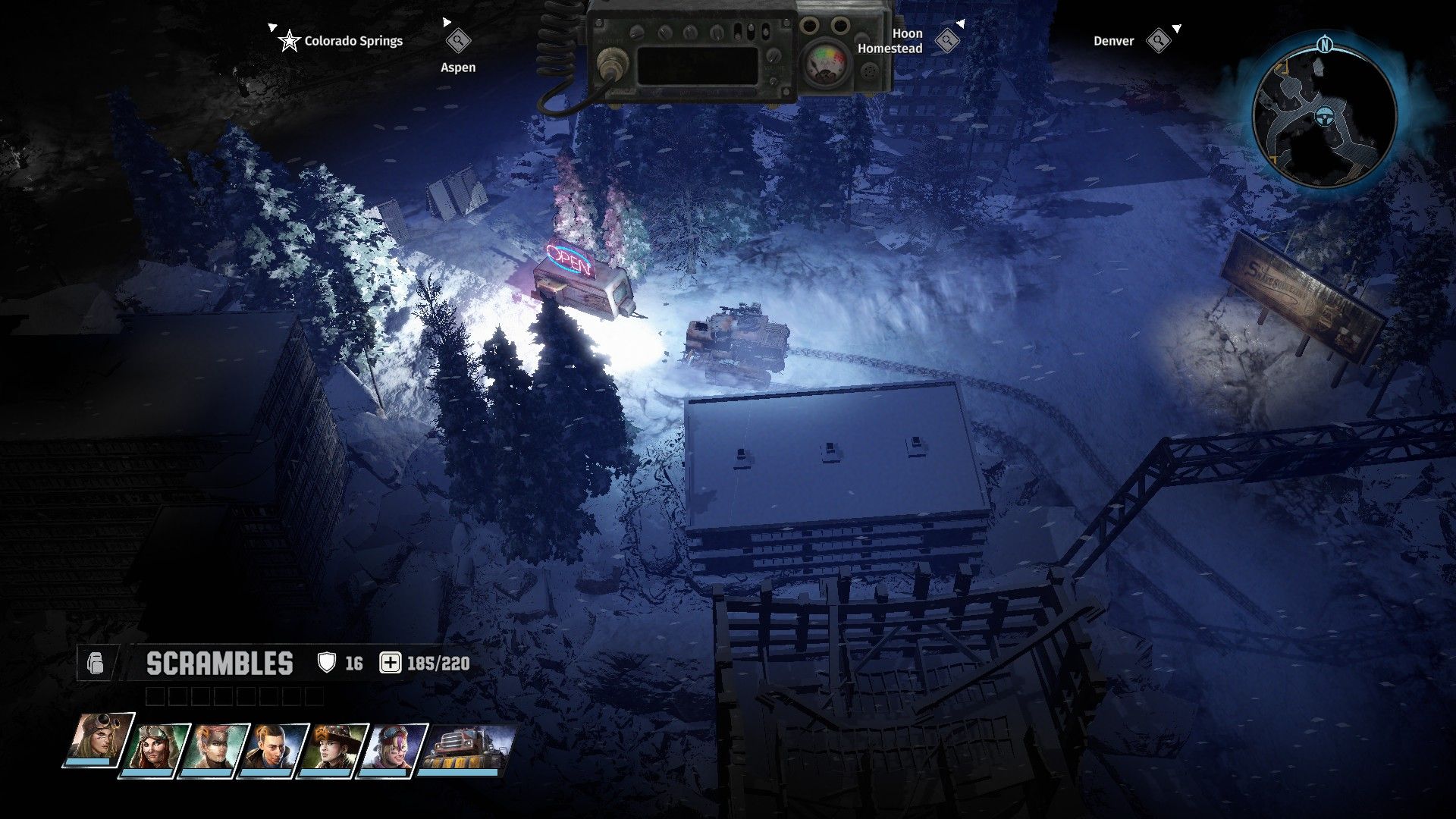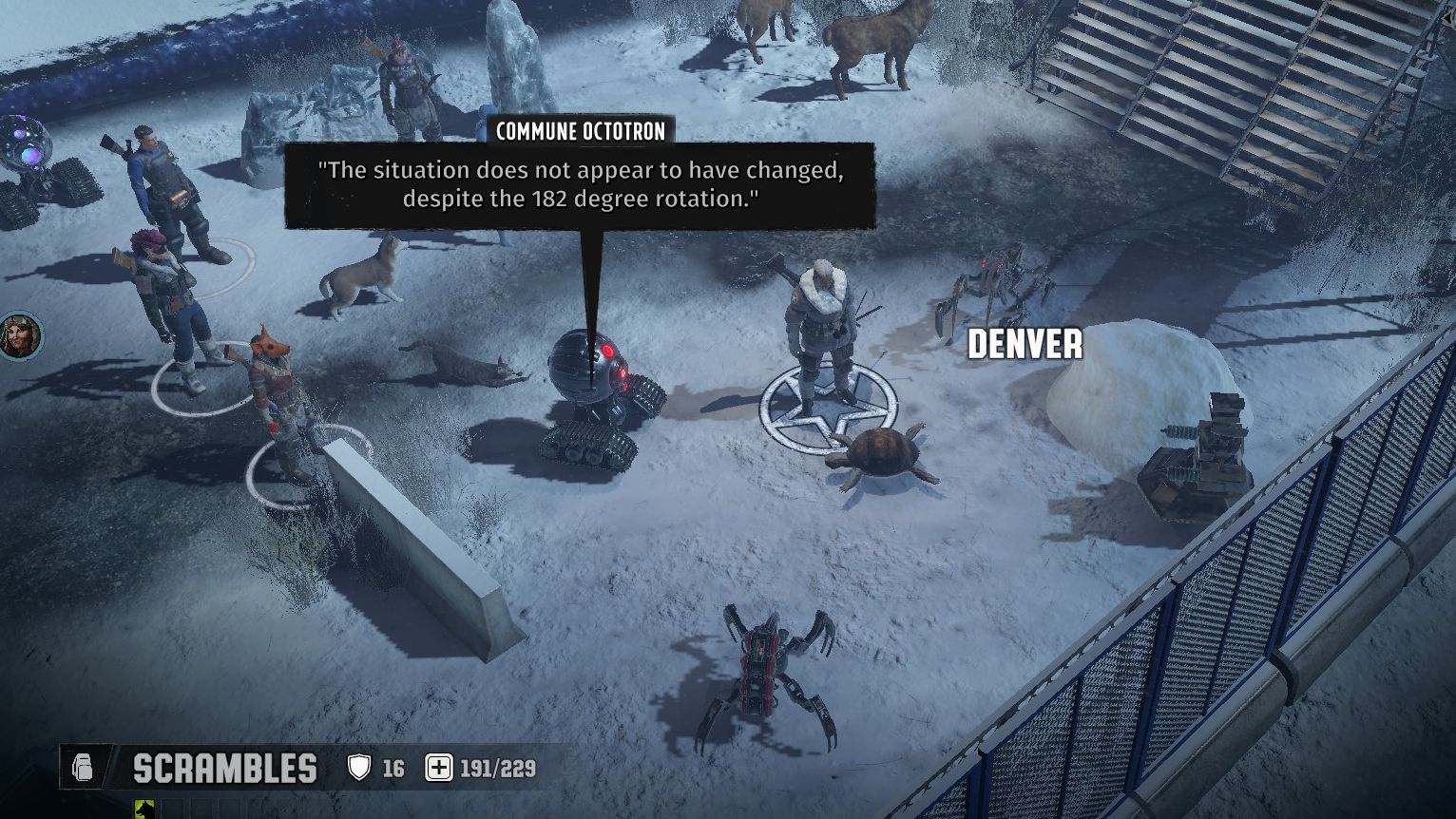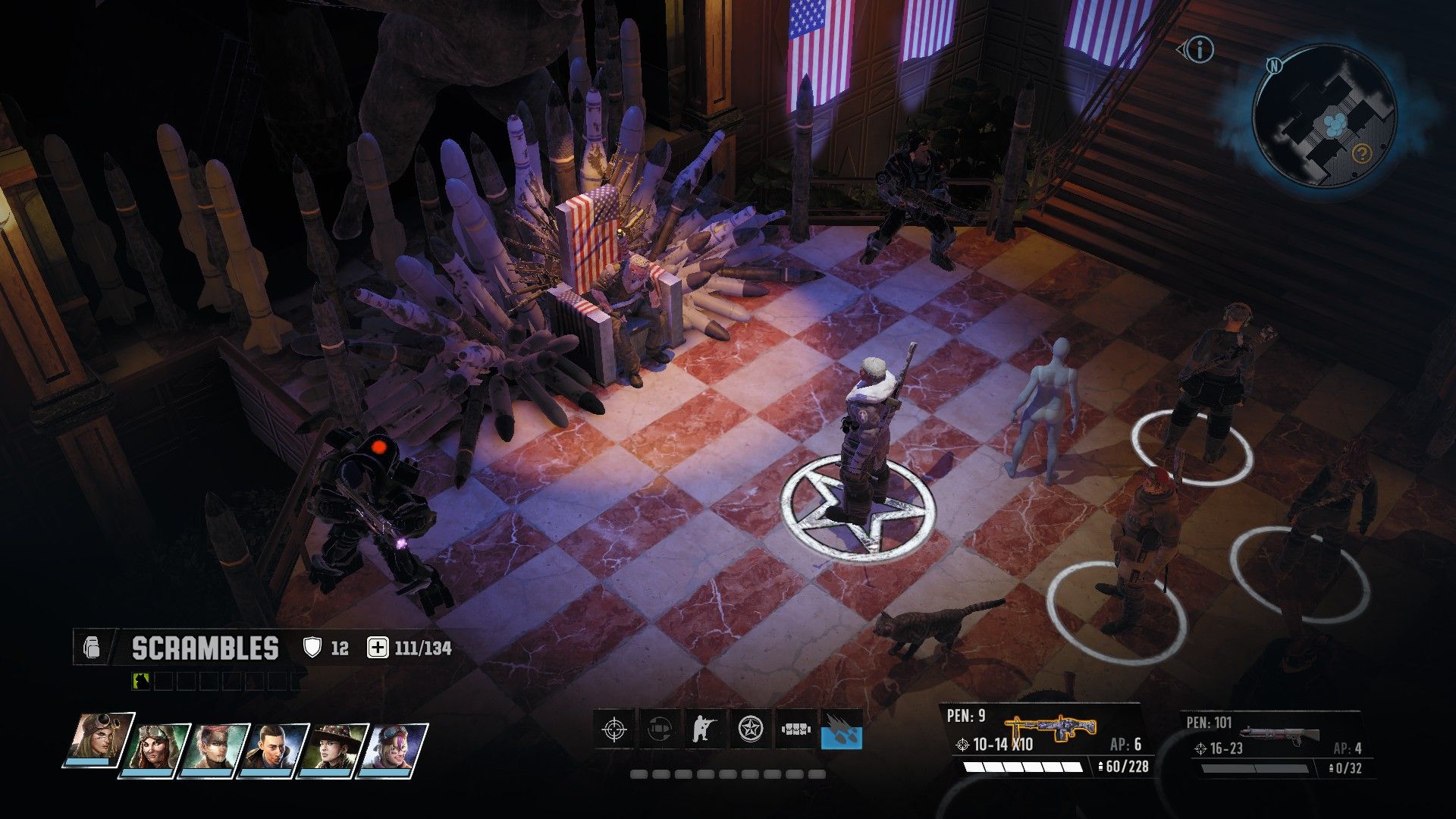Let’s start with that tale. You’re playing as a couple of Desert Rangers, heroes of Arizona who have mushed North seeking foreign aid from the iron fist leader of Colorado, a man with a big hammer who calls himself The Patriarch.
From there you embark on missions for the myriad eyeballing factions of this frozen state, adding troops and helpers to your makeshift headquarters in an old Air Force base. It’s a big, isometric, top-down walkabout of favours for favours, full of silly post-apocalypticana. There is a blood-crazed hillbilly gang who refer to all members of their sect as “cousin”. Violent cultists who will skin you alive and strap you to a kite. The robots of this future, as ever, do a lot of the heavy comic lifting, with fritzy security bots begging you to end their suffering, and a commune of machines who gather in a circle to observe a dead, upside-down turtle in the snow. They discuss the deceased creature at length, like a sort of book club. It’s also a game of dialogue, skill checks, and consequence. Release a prisoner early in the game and who knows if he will go on to harm people or somehow return the good will. Early in the game, I ignored one family’s call for help on the radio and chose to secure a shipment of super-armour from an attack by bandits. When I dusted my hands and returned to town, I saw the settlement’s law enforcers now wearing the upgraded armour and thought: “Ah, that’ll be annoying if I have to fight them.” Later, a young man ambushed me on the road with a rocket launcher, screaming that I had abandoned his family to fate. Don’t worry, I ran him over with my big truck.
This is a very small sample from a much larger, twisting web of action and reaction. Some of my decisions had a far heavier aftermath (and body count). For this it ought to be praised. Such forky-path storytelling in big games feels rarer and rarer. It gets extra points for being fully voiced, with decent acting too. Nobody is going to win any Oscars but the cast really ham it up admirably to the exact drama levels required for erratic robots and face-pierced raiders. And that’s just the baddies. Your own squad is a roster of wacky gun buddies you can swap around with every trip back to HQ. At one point my team contained some of the following reprobates: a blue-skinned clone in underwear, a cyborg chicken, a coghead with a mullet, a sad fascist with a gun for an arm, a disco robot, a mutant porcupine, a man in a suit who speaks only in Latin and stalks me everywhere at a distance. This list is not exhaustive. Aside from named folks, character creation lets you make new weirdos and add them to the team mid-game (albeit with beginner-level stats). However, some of these characters (the chicken, the porcupine, the discobot) are merely “companions” you cannot control.
There are some starter characters with a bit of story to them (a father and daughter, two nerdy lovers, etc.) but I created my own with quirks that both help and hinder. Beamer is a pyromaniac, with added explosive damage. She will occasionally set herself on fire. Scrambles is a boss who will enter a berserker rage if one of her allies is downed in a fight, granting an extra chance to land critical hits with her gigantogun. But when the rage wears off, she has less action points to spend for a couple of turns, tired as she is from the fury. But what is all this? Action points? Critical hits? Oh yes, I forgot to explain the fighty bits.
When a fight breaks out, a handy grid appears over the terrain. As with Wasteland 2, everything is very square and very turn-based. There is full cover and half-cover. You can hang back and order troops to “ambush” enemies on their next turn, or you can get up in their face with an assortment of melee or brawling weaponry. You can lob grenades, use debuffs, shoot barrels, or you can just take the straightforward route of popping shots at anyone with a high enough percentage hanging over their head. For turn-based buffs, it will feel at once fairly XCOM-ish, and fairly dull. I do prefer grid-hopping and cover-shunting to the frowny guesswork of judging distances and actions in plainer isometric RPGS like Torment: Tides Of Numenera. Yet in a world as spoiled for sublime turn-based combat as ours, with your Xcops and your Invisible Incs and your Into The Breaches and what-have-you, a humdrum take-yer-turn really stands out. The gunfights of Wasteland 3 feel fidgety and imprecise. You will get “target blocked” messages and be unable to see where your characters’ line of sight is blocked. You’ll be unable to throw grenades for unspoken reasons (Is the ceiling in the way? Can’t I lob this under-arm?). Getting your squad into positions for a surprise attack requires cumbersome one-by-one commanding, all while trying to keep watch on an enemy patroller’s circle of vision, a red outline which appears and vanishes at its own discretion.
It feels messy and, beyond that, a little boring. Most fights boil down to “shoot the bads before the bads shoot you” territory. And many of the battlefields - dentist offices, hotels, car parks, ruins - feel unimaginative in their layout, with cover that feels like it was placed willy-nilly. Some enemies have armour, which can be shredded with certain weapons or abilities. Robot foes can be hacked and animal antagonists can be tamed if you have someone on the team with the right skills. But aside from these and a few other too-subtle design quirks, I found there was barely anything to think about during a fight, aside from “which weapon shall I use?” There are exceptions. Some fights try to spice things up, by giving you a chance to get the drop on your foes with an environmental trap, for example, or by throwing the ubiquitous kamikaze exploder enemy into the mix - an unshakeable tenet of game design that ought by now to be consigned to the bottom of humanity’s foulest landfill, but maybe that’s just me. I had one desperate last stand against endless swarms of Drools (mutant ape lads) which required careful use of Molotov cocktails, corridor blocking, and heroic self-sacrifice. I really liked that fight, even if it ended in death for all involved and some retreater’s save-scumming.
But for every fight that offers a solid playground of cover and alternative tactics, there are ten uninteresting gun battles that feel like “cover, shoot, first aid” on a loop. The only fights that let you play with space are ones including your giant truck of death, a tank-tracked cube with a cannon on top that doubles up as cover for your foot soldiers. But since it crushes your non-playable companions as well as enemies, I was too often reluctant to move this vehicle into interesting positions. Get out of the way, cyborg chicken! Levelling up your characters relieves some of this staleness. Granting your mullet-sporting mechanic points to “Weird Science” will let them use grenades that shrink the enemy, for instance. Warbling ray guns that scramble brains can convert warriors to your side. Between brawls you also get to add perks every so often, like the ability to demoralise your enemy, making baddies more likely to fluff their shots. Or a perk that grants a permanent boon to your explosives, increasing the area-of-effect radius of grenades and rockets. But for the most part I never found anything that shook up combat past the point of being a run-of-the-mill turn-taker.
Then there are the bugs. Aside from the perennial problem of the odd quest glitching out or becoming mysteriously unresolvable thanks to the criss-crossing of quests, there were other noticeable game-fizzles for me. Companion characters turned invisible. An NPC thought 156 dollars was equal to 200 dollars. The word DENVER once hung ominously over everything until I restarted the game. For a long time members of my band would ignore commands I gave them during a fight, and simply shoot themselves in the face with their most powerful attack. I’m not joking. I would click “heal yourself” and they would commit suicide in a torrential blast of self-gunfire. So yes, quite a lot of busted stuff. Developers InXile have said they know about some of these issues and will “have them fixed before launch”, but considering Wasteland 2 launched with its fair share of bugs, I wouldn’t be surprised to see some of these appear in the final build of this game too. I know tolerance for bugs varies. What is rubbish to me may be forgivably rough around the edges for you. But still, you should know this stuff going in.
As uninteresting and buggy as I found the combat, it is not what eventually made me lose patience with Wasteland 3, though. That would be the overall tone of its writing. Storywise, it is a recognisably pulp affair. No harm in that. But the game’s sense of humour is firmly puerile, in-jokey, and (crucially) unrelenting. There is a brothel featuring a goat you can shag for buffing effects. Snowballs you can pee on and throw to inflict enemies with a debuff called “the stink”. A parrot who swears colourfully at his owner until you recruit him to swear colourfully at you. Ha ha, swear words! Besides that, it’s an endless stream of referential humour of the Ready Player One mold. Remember HAL 9000? Remember Missile Command? Remember Ghostbusters? Remember jokes? It feels dated in more ways than one. Even the upside-down turtle, one of the game’s funnier moments, is a winking Blade Runner gag surrounded by Futurama autobots. On top of that, I found its infrequent darker moments at odds with the prevailing wackiness of the world. Coming across a pit full of melted human corpses, adult and child alike, may have felt horrific, had I not myself, moments before, evaporated a foe called “the beastmaster” using a giant magnifying glass.
The moment-to-moment writing is defined by this overwhelming, try-hard comedy, with occasional and ultimately unconvincing stabs at satire. Saul “The Patriarch” Buchanan is the standout example, an all-American strongman who fancies himself the sole arbiter of justice and good governance in an otherwise lawless world. Having this despotic leader of Colorado sit atop a throne made of missiles and US flags is an eye-catching motif. But as a visual gag masquerading as allegorical critique, this is “Banksy running out of ideas” levels of political humour. In short, the game often makes me go: hm. But never: ha. As with most of the big iso-RPGs of the crowdfund era, it is also a bloated piece of work, and the longer it goes on the more it loses momentum. For me 100 hours is far too much time to be spent playing a fiddly, mediocre RPG that, despite being set many decades from now, feels as if it belongs quite stubbornly in the past. I suspect the game’s length is there to adhere to the old idea that you have to get your 55 quids’ worth. But if you know the clunky moving parts of the game intimately after 10 hours, and the remaining 90 hours is story filler of varying quality, then your ratio of quids-to-entertainment (if you subscribe to such a philosophy) is all screwy. This is my long-winded way of reminding you that 55 British gold ones is a lot of money and can get you loads of sweets - although it’s available on Xbox Gamepass too, so if you have that you can fill your boots with both RPG and sweets.
Again, I do understand the appeal of getting a chonky “choices matter” game like this to put it in Steam tag parlance. If you have that vacancy to fill, go ahead. Let’s face it, there aren’t many other options at the moment. I myself have made many bad calls in my time as a Ranger, and even I wouldn’t mind seeing the repercussions of my major decisions play out. But if I have to fight through listless combat, buggy UI, and an onslaught of juvenile gags to see one of the many endings, I’d rather leave the snowfields of Colorado behind. To hell with the consequences.

